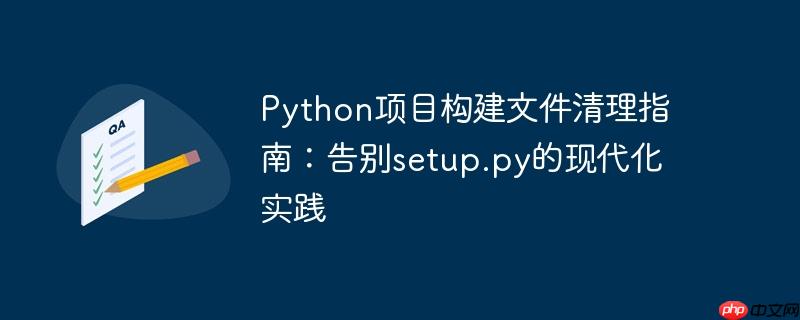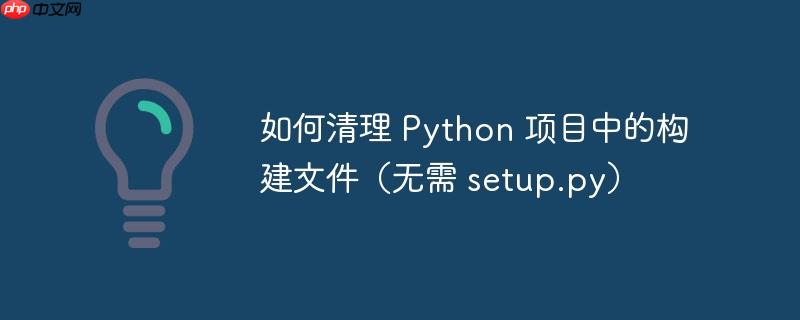
背景:从setup.py到pyproject.toml
在python项目的早期开发实践中,setup.py文件是项目配置和构建的核心。通过执行python setup.py clean --all命令,开发者可以方便地清除项目构建过程中产生的所有临时文件和目录。然而,随着python生态系统的发展,pep 517和pep 518的引入推动了标准化构建后端(如build模块)和pyproject.toml文件的普及。现在,项目通常使用pyproject.toml来声明其构建系统依赖和元数据,并通过python -m build等命令进行构建。
这种转变带来了一个问题:对于不再包含setup.py文件的项目,传统的clean命令已不再适用。因此,理解并掌握手动或脚本化清理这些构建产物的方法,对于维护项目整洁和解决潜在的构建问题至关重要。
核心清理目标:常见的构建产物
在没有setup.py的情况下,构建工具(如build、setuptools等)或Python解释器本身在运行过程中会生成一系列临时文件和目录。这些是清理工作的核心目标:
-
__pycache__ 目录
- 作用: Python解释器为了提高模块加载速度而缓存编译后的字节码(.pyc文件)。
- 清理原因: 包含旧的或不必要的字节码,可能导致模块行为异常或占用空间。
-
*`.pyc` 文件**
- 作用: 编译后的Python字节码文件,通常存在于__pycache__目录中,但在某些情况下也可能直接存在于源代码目录。
- 清理原因: 同__pycache__,移除过时或冗余的字节码。
-
.swp 文件
- 作用: 某些文本编辑器(如Vim)在编辑文件时创建的交换文件,用于崩溃恢复。
- 清理原因: 属于临时文件,通常在编辑器正常退出后自动删除,但异常情况下可能残留。
-
build 目录
- 作用: 由构建工具(如setuptools、build)生成,包含编译后的C扩展、中间文件、以及打包前的临时构建内容。
- 清理原因: 存储了项目的中间构建状态,重新构建时应从干净状态开始。
-
dist 目录
- 作用: 包含最终分发的包文件,如.whl(wheel)和.tar.gz(source distribution)。
- 清理原因: 移除旧版本或不成功的构建包,确保发布的是最新且正确的版本。
-
*.egg-info 或 *.dist-info 目录
- 作用: 包含项目的元数据,由setuptools等工具生成。
- 清理原因: 有时在重新构建或更改项目元数据后,清理这些目录可以避免冲突。
-
测试缓存目录 (例如 .pytest_cache)
- 作用: 测试框架(如pytest)为了加速测试运行而缓存的信息。
- 清理原因: 移除旧的测试结果或缓存,确保测试环境的干净。
-
类型检查缓存目录 (例如 .mypy_cache)
- 作用: 类型检查工具(如mypy)缓存的类型信息。
- 清理原因: 在代码或配置更改后,清理缓存以强制重新检查。
实战清理方法
由于没有统一的clean命令,我们需要通过手动或脚本化的方式来删除这些文件和目录。
1. 手动删除
对于小型项目或不频繁的清理操作,可以直接通过文件管理器导航到项目目录,然后手动删除上述提到的文件和目录。
2. 命令行清理
这是最常用且高效的方法,适用于各种操作系统。
a. Linux / macOS (使用 find 和 rm)
在终端中,进入项目根目录,然后执行以下命令:
# 清理 __pycache__ 目录
find . -type d -name "__pycache__" -exec rm -rf {} +
# 清理 *.pyc 文件
find . -type f -name "*.pyc" -delete
# 清理 .swp 文件
find . -type f -name "*.swp" -delete
# 清理 build 目录
rm -rf build
# 清理 dist 目录
rm -rf dist
# 清理 *.egg-info 或 *.dist-info 目录
find . -type d -name "*.egg-info" -exec rm -rf {} +
find . -type d -name "*.dist-info" -exec rm -rf {} +
# 清理测试和类型检查缓存
rm -rf .pytest_cache
rm -rf .mypy_cache
# 综合清理命令 (推荐在项目根目录执行)
echo "Cleaning Python build artifacts..."
find . -type d -name "__pycache__" -exec rm -rf {} +
find . -type f -name "*.pyc" -delete
find . -type f -name "*.swp" -delete
rm -rf build dist .pytest_cache .mypy_cache
find . -type d -name "*.egg-info" -exec rm -rf {} +
find . -type d -name "*.dist-info" -exec rm -rf {} +
echo "Cleaning complete."b. Windows (使用 for /D 和 del)
在PowerShell或命令提示符中,进入项目根目录,然后执行以下命令:
# 清理 __pycache__ 目录
Get-ChildItem -Path . -Recurse -Directory -ErrorAction SilentlyContinue | Where-Object { $_.Name -eq "__pycache__" } | Remove-Item -Recurse -Force
# 清理 *.pyc 文件
Get-ChildItem -Path . -Recurse -Include *.pyc -ErrorAction SilentlyContinue | Remove-Item -Force
# 清理 .swp 文件
Get-ChildItem -Path . -Recurse -Include *.swp -ErrorAction SilentlyContinue | Remove-Item -Force
# 清理 build 目录
Remove-Item -Path "build" -Recurse -Force -ErrorAction SilentlyContinue
# 清理 dist 目录
Remove-Item -Path "dist" -Recurse -Force -ErrorAction SilentlyContinue
# 清理 *.egg-info 或 *.dist-info 目录
Get-ChildItem -Path . -Recurse -Directory -ErrorAction SilentlyContinue | Where-Object { $_.Name -like "*.egg-info" -or $_.Name -like "*.dist-info" } | Remove-Item -Recurse -Force
# 清理测试和类型检查缓存
Remove-Item -Path ".pytest_cache" -Recurse -Force -ErrorAction SilentlyContinue
Remove-Item -Path ".mypy_cache" -Recurse -Force -ErrorAction SilentlyContinue
# 综合清理命令 (推荐在项目根目录执行)
Write-Host "Cleaning Python build artifacts..."
Get-ChildItem -Path . -Recurse -Directory -ErrorAction SilentlyContinue | Where-Object { $_.Name -eq "__pycache__" } | Remove-Item -Recurse -Force
Get-ChildItem -Path . -Recurse -Include *.pyc, *.swp -ErrorAction SilentlyContinue | Remove-Item -Force
Remove-Item -Path "build", "dist", ".pytest_cache", ".mypy_cache" -Recurse -Force -ErrorAction SilentlyContinue
Get-ChildItem -Path . -Recurse -Directory -ErrorAction SilentlyContinue | Where-Object { $_.Name -like "*.egg-info" -or $_.Name -like "*.dist-info" } | Remove-Item -Recurse -Force
Write-Host "Cleaning complete."3. 利用 .gitignore 文件
虽然.gitignore不能直接清理已存在的文件,但它能阻止这些临时文件被误提交到版本控制系统,从而保持仓库的整洁。在项目的.gitignore文件中添加以下条目:
# Byte-code files __pycache__/ *.pyc # Build artifacts build/ dist/ *.egg-info/ *.dist-info/ # Editor swap files *.swp # Testing and type checking caches .pytest_cache/ .mypy_cache/ # Other common temporary files .coverage .venv/ # If you manage virtual environment inside the project folder venv/
4. 自动化清理脚本或任务运行器
对于大型项目或团队协作,将清理命令封装成一个脚本或使用任务运行器(如Makefile、invoke、npm scripts)是一个更好的选择。
a. Python 清理脚本 (clean.py)
可以在项目根目录创建一个clean.py脚本:
import shutil
import glob
import os
def clean_build_artifacts():
"""Removes common Python build artifacts and temporary files."""
print("Cleaning Python build artifacts...")
# Directories to remove
dirs_to_remove = [
"build",
"dist",
"__pycache__",
".pytest_cache",
".mypy_cache",
]
for d in dirs_to_remove:
if os.path.exists(d):
print(f" Removing directory: {d}")
shutil.rmtree(d)
# Files to remove
file_patterns_to_remove = [
"**/*.pyc",
"**/*.swp",
"**/*.egg-info",
"**/*.dist-info",
]
for pattern in file_patterns_to_remove:
# Use glob.glob with recursive=True for Python 3.5+
for f in glob.glob(pattern, recursive=True):
if os.path.isfile(f) or os.path.isdir(f): # Check if it's a file or dir
print(f" Removing: {f}")
if os.path.isfile(f):
os.remove(f)
else: # It's a directory
shutil.rmtree(f)
print("Cleaning complete.")
if __name__ == "__main__":
clean_build_artifacts()然后通过 python clean.py 执行清理。
b. Makefile (Linux/macOS)
在项目根目录创建Makefile文件:
.PHONY: clean
clean:
@echo "Cleaning Python build artifacts..."
find . -type d -name "__pycache__" -exec rm -rf {} +
find . -type f -name "*.pyc" -delete
find . -type f -name "*.swp" -delete
rm -rf build dist .pytest_cache .mypy_cache
find . -type d -name "*.egg-info" -exec rm -rf {} +
find . -type d -name "*.dist-info" -exec rm -rf {} +
@echo "Cleaning complete."然后通过 make clean 执行清理。
注意事项
- 谨慎操作: 在执行任何删除命令之前,请务必确认您正在操作正确的目录,并了解这些文件和目录的作用。错误地删除关键文件可能导致项目无法运行。
- 备份: 对于重要项目,在进行大规模清理之前进行备份是一个好习惯。
- 理解通配符: 使用rm -rf *或del *等命令时要格外小心,确保只删除目标文件,避免误删。
- 环境隔离: 始终在项目的虚拟环境(venv或conda env)中进行开发和构建,这有助于将项目依赖和构建产物隔离,避免污染系统环境。
- 区分生产与开发: 在生产环境中,通常只需要部署最终的包文件,不需要保留构建过程中的临时文件。
总结
随着Python项目构建工具和实践的演进,setup.py的传统清理方式已逐渐被淘汰。适应这一变化,掌握手动识别和清理构建产物的方法,并通过命令行工具、.gitignore或自动化脚本来管理项目整洁,是现代Python开发者必备的技能。定期清理不仅能释放磁盘空间,还能避免因旧的构建缓存导致的潜在问题,确保项目始终在一个干净、可控的环境中运行和构建。
以上就是Python项目构建文件清理指南:告别setup.py的现代化实践的详细内容,更多请关注资源网其它相关文章!




发表评论:
◎欢迎参与讨论,请在这里发表您的看法、交流您的观点。